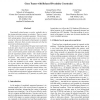820 search results - page 21 / 164 » Using Multiple Alignments to Improve Gene Prediction |
CSB
2005
IEEE
14 years 1 months ago
2005
IEEE
Functionally related genes co-evolve, probably due to the strong selection pressure in evolution. Thus we expect that they are present in multiple genomes. Physical proximity amon...
NAR
2000
13 years 7 months ago
2000
Version 2.1 of ASDB (Alternative Splicing Data Base) contains 1922 protein and 2486 DNA sequences. The protein entries from SWISS-PROT are joined into clusters corresponding to al...
BMCBI
2010
13 years 7 months ago
2010
Background: While most multiple sequence alignment programs expect that all or most of their input is known to be homologous, and penalise insertions and deletions, this is not a ...
BMCBI
2004
13 years 7 months ago
2004
Background: Existing sequence alignment algorithms assume that similarities between DNA or amino acid sequences are linearly ordered. That is, stretches of similar nucleotides or ...
BMCBI
2007
13 years 7 months ago
2007
Background: Joint alignment and secondary structure prediction of two RNA sequences can significantly improve the accuracy of the structural predictions. Methods addressing this p...

